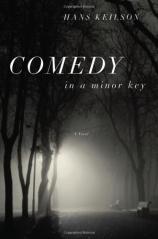Reading Group Guide
Discussion Questions
Comedy in a Minor Key

1. What makes Comedy in a Minor Key different from other tales of the resistance that you have read? In what ways is fiction (especially wry fiction) sometimes the best means for conveying historical fact?
2. Midway through chapter ten, Hans Keilson describes Marie’s disappointment over Nico’s death: “She had secretly imagined what it would be like on liberation day, the three of them arm in arm walking out of their house. Everyone would see right away what he was from his pale face…It would give them a little sense of satisfaction, and everyone who makes a sacrifice needs a little sense of satisfaction.” Is Keilson’s satire also realistic? What motivates the benevolent people you know?
3. How did the novel’s timeline affect you? How did your impressions of Nico shift as you learned about him through a series of flashbacks?
4. What makes Nico alluring to Marie? Is he at the mercy of his caregivers, or does he exert power over them in some ways? Are any aspects of his life still in his control?
5. The book’s closing line offers an image of life for Wim and Marie without Nico. How was their marriage transformed by him?
6. Keilson’s work contains many elements of 20th-century existentialism, for which Camus and Kafka became well known. What is unique about Keilson’s perspective on human existence? What does his book say about our obligations to one another, and the nature of suffering in the world?
7. How might the story have unfolded if it had been told from Nico’s point of view? What does he think of Wim and Marie?
8. Born in Germany, Hans Keilson became a physician and was forced to flee to the Netherlands in 1936 after the Nuremberg Laws made it illegal for Jews to practice medicine in Germany. He was active in the Dutch resistance. Does Keilson’s biography shape the way you read this work, or is a novelist’s biography irrelevant?
9. Much of the tragicomedy in the novel lies in the predicament of how to dispose of Nico’s body. How did you react to this? What universal experiences are captured in these images?
10. Discuss the role of Coba, Wim’s sister. What does it mean to Marie to have Coba’s companionship and support? How is Coba different from her brother?
11. When Keilson’s novel The Death of the Adversary was named a best book of the year by Time in 1962, the magazine’s reviewer wrote that Keilson’s work examines why there was widespread ambivalence toward the Holocaust while it was unfolding. What portraits of ambivalence are offered in Comedy in a Minor Key? As Dr. Nelis fabricates a reason to call on Wim and Marie’s house, and the laundry-tag issue is resolved with the help of local police, what message does Keilson give us about ambivalence versus resistance?
12. What impressions of Judaism do the novel’s non-Jews offer? How does Marie understand Nico’s distinction between a religious identity and a cultural one?
13. The author chose to make Nico a perfumier. What is ironic about this? What do we learn about him in chapter four as he makes suggestions for Marie’s ideal scent?
14. What does Comedy in a Minor Key say about the time period during which it was written? What is the difference between reading it in 1947 as a new release, and reading it in the twenty-first century as a classic? Is there any contemporary equivalent to the genocide Nico faces in the novel?
15. What elements of Comedy in a Minor Key echo the persecution described in The Death of the Adversary? Read together, do the storylines complement or contradict each other?
Comedy in a Minor Key
- Publication Date: July 20, 2010
- Hardcover: 135 pages
- Publisher: Farrar, Straus and Giroux
- ISBN-10: 0374126755
- ISBN-13: 9780374126759







